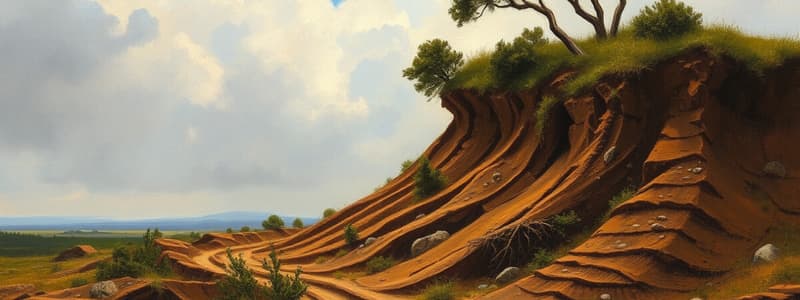Podcast
Questions and Answers
What is the term used to describe the movement of soil as a result of water?
What is the term used to describe the movement of soil as a result of water?
- Soil displacement
- Land degradation
- Water run-off
- Soil erosion (correct)
Which of the following best describes the phenomenon when water vapor interacts with contaminants in the atmosphere, leading to harmful effects on living organisms?
Which of the following best describes the phenomenon when water vapor interacts with contaminants in the atmosphere, leading to harmful effects on living organisms?
- Acid rain (correct)
- Eutrophication
- Flash floods
- Soil erosion
What environmental problem is primarily caused by excessive nutrients from fertilizers entering bodies of water?
What environmental problem is primarily caused by excessive nutrients from fertilizers entering bodies of water?
- Eutrophication (correct)
- Soil erosion
- Acid rain
- Drought
What is the significant effect of long periods with little precipitation?
What is the significant effect of long periods with little precipitation?
Which condition is associated with an excess of precipitation occurring in a short timeframe, resulting in sudden accumulation of water?
Which condition is associated with an excess of precipitation occurring in a short timeframe, resulting in sudden accumulation of water?
Which factor most directly affects the decomposition of organic matter in soil?
Which factor most directly affects the decomposition of organic matter in soil?
What is the primary role of autotrophs in an ecosystem?
What is the primary role of autotrophs in an ecosystem?
Which type of organism is classified as a consumer that only eats plants?
Which type of organism is classified as a consumer that only eats plants?
How does soil water content influence biological activities in soil?
How does soil water content influence biological activities in soil?
What role do decomposers play in an ecosystem?
What role do decomposers play in an ecosystem?
What relationship describes a situation where one organism benefits while another is negatively affected?
What relationship describes a situation where one organism benefits while another is negatively affected?
Which category of ecosystem role directly consumes plants?
Which category of ecosystem role directly consumes plants?
In a food web, secondary consumers typically eat what?
In a food web, secondary consumers typically eat what?
Which statement is true regarding the first law of thermodynamics?
Which statement is true regarding the first law of thermodynamics?
What type of relationship is mutualism?
What type of relationship is mutualism?
What is the primary role of decomposers in an ecosystem?
What is the primary role of decomposers in an ecosystem?
What best describes a feature of protocooperation?
What best describes a feature of protocooperation?
In what situation would competition between two organisms occur?
In what situation would competition between two organisms occur?
What is the primary function of primary producers in an ecosystem?
What is the primary function of primary producers in an ecosystem?
Which of the following is an example of a consumer in an ecosystem?
Which of the following is an example of a consumer in an ecosystem?
Flashcards are hidden until you start studying
Study Notes
Environmental Damage Phenomena
- Run-off collects water, filling watersheds and dams.
- Soil erosion occurs due to water movement, causing environmental concerns.
- Wind affects water vapor movement and creates localized wind forms.
- Acid rain results from water vapor contacting contaminants like sulfur and nitric acid, harming living organisms.
- Eutrophication arises when fertilizers run-off into water bodies, leading to rapid plant growth that outcompetes other species.
- Drought, or “El Niño,” occurs with insufficient precipitation, causing water scarcity.
- Flash floods, or “La Niña,” happen when excessive precipitation accumulates quickly in areas unable to drain.
- Sinkholes can form when water storage basins deplete due to low precipitation, leading to sudden collapses.
Soil and Physiographic Factors
- Soil texture (sand, silt, loam, clay) influences plant and animal types supported in the area.
- Soil temperature impacts organic matter decomposition rates.
- Soil water, pH, and nutrient availability affect biological activities.
- Physical characteristics of an area (altitude, sunlight, rainfall, slope) shape vegetation types.
Biotic Components and Nutritional Relationships
- Autotrophs capture energy from sunlight to produce organic compounds; they act as producers.
- Heterotrophs require preformed organic nutrients, consuming other organisms; they are categorized into herbivores, carnivores, and omnivores.
- Decomposers, like bacteria and fungi, break down dead matter to return nutrients to the ecosystem.
Nutritional Relationships Overview
- Competition: Two organisms utilize the same resources.
- Parasitism: One organism benefits at the host's expense.
- Predation: Predators feed on prey.
- Commensalism: One organism benefits without affecting the other.
- Protocooperation: Both organisms benefit, but it's not obligatory.
- Mutualism: Both benefit, and the relationship is obligatory.
Ecosystem Roles
- Producers: Convert simple organic molecules through photosynthesis (e.g., grasses, trees).
- Consumers: Use organic matter for food; include herbivores, carnivores, omnivores, scavengers, and parasites.
- Decomposers: Recycle organic material into inorganic forms (e.g., bacteria, fungi).
- Detritivores: Consume decaying organic matter for nourishment.
Food Web and Trophic Levels
- Primary Producers: Plants like Acacia and start grass.
- Primary Consumers: Herbivores such as termites, giraffes, and zebras.
- Secondary Consumers: Carnivores like lions and cheetahs thrive on primary consumers.
Energy Flow and Thermodynamic Principles
- Cellular respiration releases heat to the environment while transferring energy to carnivores.
- Energy is also allocated to detritus feeders through processes like death, excretion, and defecation.
- The First Law of Thermodynamics states energy cannot be created or destroyed, only transformed from one form to another.
Studying That Suits You
Use AI to generate personalized quizzes and flashcards to suit your learning preferences.




